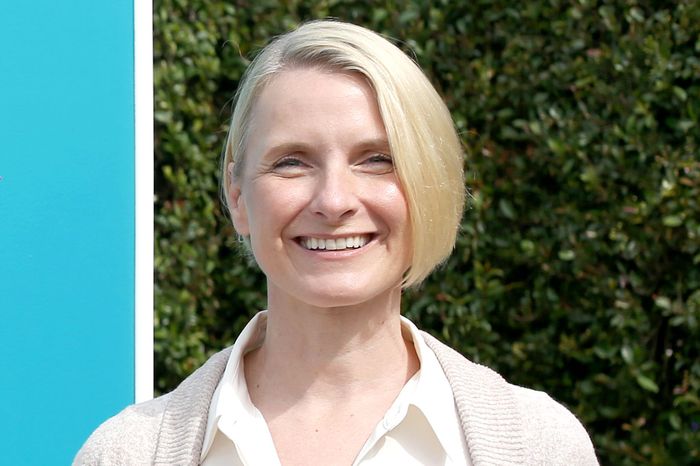
“You will never be an interesting person,” the glamorous, accomplished, 50-something theater actress Edna Parker Watson calmly says to Vivian, the protagonist and narrator of Elizabeth Gilbert’s new World War II–era novel, City of Girls. “I’m telling you this …” she goes on, “because I believe you’ve been laboring under the misconception that you are interesting or that your life has significance. But you are not and it doesn’t.”
Unfortunately for readers, Edna is right. Vivian, who begins the novel as a naïve, silly 19-year-old and ends it a slightly wiser octogenarian, is a blank, a TV turned to static—fuzzy, mildly distracting, and ultimately an annoyance. Why an accomplished novelist like Gilbert would so blithely expose the hole where her protagonist’s personality ought to be, I don’t know. But Vivian is dull, and, what’s worse, there is nothing intriguing about her dullness. It takes almost 300 pages for Edna to let Vivian know, but we see it from page one.
Before Eat, Pray, Love cannonballed into the psyches of forlorn, wanderlust-infected 40ish women everywhere, Gilbert was a critically admired if relatively unfamous fiction writer. In 1993, a short story from Pilgrims, her first collection, ran in Esquire with the promising headline, “The Debut of an American Writer.” Her first novel, Stern Men, a Maine-set story about two feuding islands and lobster fishing, was quietly praised. But finding her chi and then transcribing that psycho-emotional adventure into the kind of memoir that single-handedly revived tourism for a remote island brought Gilbert the level of literary celebrity that guarantees sales and ticketed book tours in pepetuity. It was no surprise when she followed up Eat, Pray, Love, which chronicles Gilbert’s preoccupation with her newly partnerless self, with Committed, another memoir — this time about her second marriage — that picked up where the phenomenon left off.
Then, in 2013, Gilbert swung back to fiction. By that point — 20 years after her publishing debut — her fame had so insulated her from the second-guesses of publishers that, after they reached an impasse on her forthcoming novel’s cover, she simply let fans decide in a Facebook contest. (Ever devoted, her fans chose the cover Gilbert had been rooting for.) Fearing the kitsch that might emerge from a woman who’d spent the past decade praising the Pinterest-quotable joys of opening herself up to love, I worried that The Signature of All Things would lean too much on Gilbert the TED Talker and not enough on her imagination or the stark, powerful prose of her early work.
I was wrong. The Signature of All Things employed the themes that had made Gilbert such an object of fascination — the suppression of women’s sexuality, the worrisome urge to wander outside one’s comfort zone, the simultaneous loneliness and fulfillment of the intellectual life. Better yet, it was a joy to read — moving, graceful, and in thrall to its microscopic world.
Its protagonist, Alma Whittaker, a mid-19th-century botanist and heiress, is sexually eager and romantically inclined, but she keeps what she calls her “habit of self-pleasure” limited to her own body, as she furiously masturbates in the binding closet of her father’s library while reading Cum Grano Salis, “an honest accounting of [a] lifetime of erotic adventure.” Yet these cramped explorations, along with a disastrous crush on a man who instead marries her dainty sister, don’t leave her sexuality bound and withered. Instead, in that marvelous novel (so good I read it for pleasure twice — a rarity) her repression functions as a springboard, eventually launching Alma to faraway lands and adventures.
Six years later, my excitement over a new historical novel from Gilbert led me to put it on Vulture’s list of the most anticipated books of 2019 before I even had a copy in hand. City of Girls, I wrote, “about a young woman in the sparkling and salacious theater world of 1940s New York, looks to be another story about the barriers women face — and catapult — while pleasure-seeking.” All of that is true. But where Alma pioneers a new way for women to live and brings attention to unseen worlds (like the lichens she studies), Vivian is all feathers and glitter — a sparkly story stitched onto a formless narrative garment that forgets all the lessons Gilbert has learned (and imparted) about the so-called plight of single, sexually voracious women.
Recently “excused” from Vassar’s class of 1943 after failing “every single one” of her freshman exams and ranking second-to-last (ahead of a girl with polio), Vivian is sent to live in New York City with her aunt Peg, who owns a buckling theater full of balding velvet near Times Square. Already we have arrived at a shaky premise — that buttoned-up mining magnates in Westchester would send their aimless daughter to a bohemian den of iniquity to cure her wayward ways. Vivian ends up working behind the scenes at the Lily Playhouse, putting to use the masterful sewing skills her late grandmother taught her, stitching up costumes for showgirls and ameteur actors in cobbled-together two-bit musical melodramas.
It’s there that Vivian meets and pseudo-platonically falls for showgirl Celia Ray, a “sultry brunette” whose beauty is so apparent that, to use just one of Gilbert’s many clichés, “a Martian could have noticed it … from Mars.” (Italics in this novel do more heavy lifting than Dwayne Johnson on arm day.) Celia moves into Vivian’s far superior apartment (and bed), dressing her Pygmalion in “the thinnest little stalks of evening gowns” and turning her into the kind of glamour girl who tipples cocktails and seduces men while Count Basie himself takes a seat at the piano. One weekend, Celia and a few other showgirls take Vivian to the home of a “boring” but “respected” man they call Dr. Kellogg to lose her virginity in private (and earn a little cash — a tense moment that is treated as mere frippery). From then on, Vivian explains, “Celia and I didn’t have sex with all the men we met that summer. But we did have sex with most of them.”
Peg’s Hollywood-producer ex-husband assembles a show fine enough for a star like Edna, offering a glimpse into the inner workings of the mid-century New York theater world that is as engaging as all the sequined gowns might suggest. But City of Girls then skips willy-nilly through the rest of Vivian’s life, compressing decades into sentences and lingering on like a comatose patient without a living will. She has sex, makes friends, sews a bit, walks the city, and remains shut off to her own interiority all the while.
In an interview with Marie Claire, Gilbert explained that the impetus behind this novel was the feeling that “there was something missing in the Western canon of literature, a story about women with really active sex lives whose lives are not destroyed by it.” Nevermind that near-ruination is the fulcrum this entire story swings on: The problem here is that Gilbert writes as if having a ton of sex — “in fancy hotel suites … in the kitchen of a small East Side nightclub … on a ferry boat … in the backs of taxicabs … in a movie theatre … in Bryant Park, with the threat of rats at our feet” — is a replacement for a personality. Promiscuity as defining character trait might work if either the character or the author is self-aware. Instead, Vivian’s never-ending references to her carnal knowledge become the equivalent of a drunk woman’s wink and elbow nudge down a long, empty bar.
It feels as if Gilbert is so immersed in her mission — to let Vivian’s body loose in New York without bringing down hellfire — that she loses sight of how a ravenous sex drive can send tremors out to other aspects of our selves, how confidence or disenchantment trickle into our work, our friendships, our relationship with the world at large. Vivian isn’t delighted by or infatuated with or even fascinated by her self. She merely lives, and meets some showgirls, and has sex, and moves on. This novel is simply an idea walking around pretending to be a fleshed-out character study.
In a 2015 essay for The New York Times Magazine, titled “Confessions of a Seduction Addict,” Gilbert wrote, “Seduction was never a casual sport for me; it was more like a heist, adrenalizing and urgent. I would plan the heist for months, scouting out the target, looking for unguarded entries. Then I would break into his deepest vault, steal all his emotional currency and spend it on myself.” This is ground she knows well: Gilbert’s hunger for affection and accord informed every sentence of Eat, Pray, Love’s desperation and fulfillment narrative. She earned her fame and her thought-leader status (with pop-ins on Oprah’s Super Soul Conversations podcast, at Gwyneth’s In Goop Health Summit, and on speaking stages throughout the land) preaching a refrigerator-magnet message of growth and adaptability. What’s woeful here is that Gilbert is the ideal candidate to help Vivian unfold just as unpredictably as Alma Whittaker did. Instead, she stays a tight, closed bud.
A woman’s thirsty sex drive is one of the facets of the human psyche most deserving of refreshing, surprising turns in literature (when will we get the next Lady Chatterly?). With the right touch Vivian might have fired up insightful debates about whether women owe the world thoughtfulness over their sexcapades or how a character can effectively live outside of the great world drama of her age. Gatsby’s Daisy Buchanan is proof enough that Champagne coupes and placid beauty can be used to great effect. In City of Girls, Gilbert sends Vivian on innumerable gambols but never adds them up to anything approaching a worldview or even an attitude. This sex is as meaningless for the reader as it is for Vivian.
Lurking inside the middle of all this is an analogy too uncanny to resist. The Lily Playhouse isn’t Broadway; its shows are a hastily composed Mad Libs of melodrama combined with jiggling breasts and high kicks. Vivian adores them anyway. “They were designed to make people happy,” she says, “without making the audience work too hard to understand what was going on.” We could say the same thing about City of Girls.


